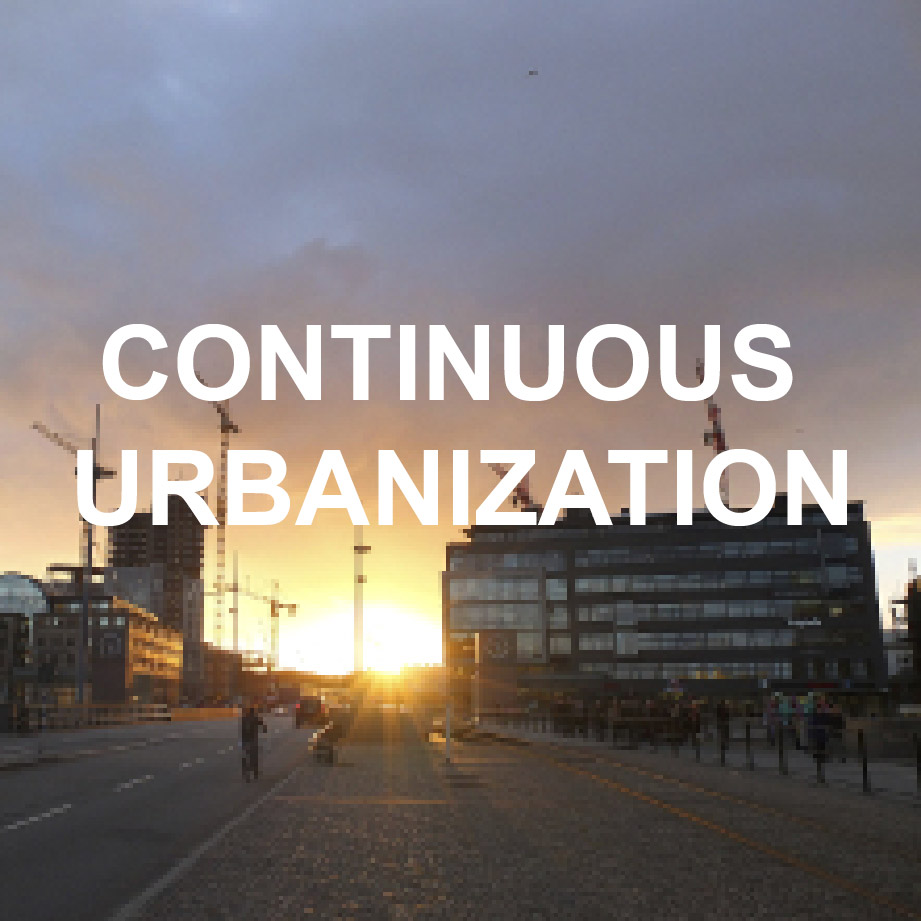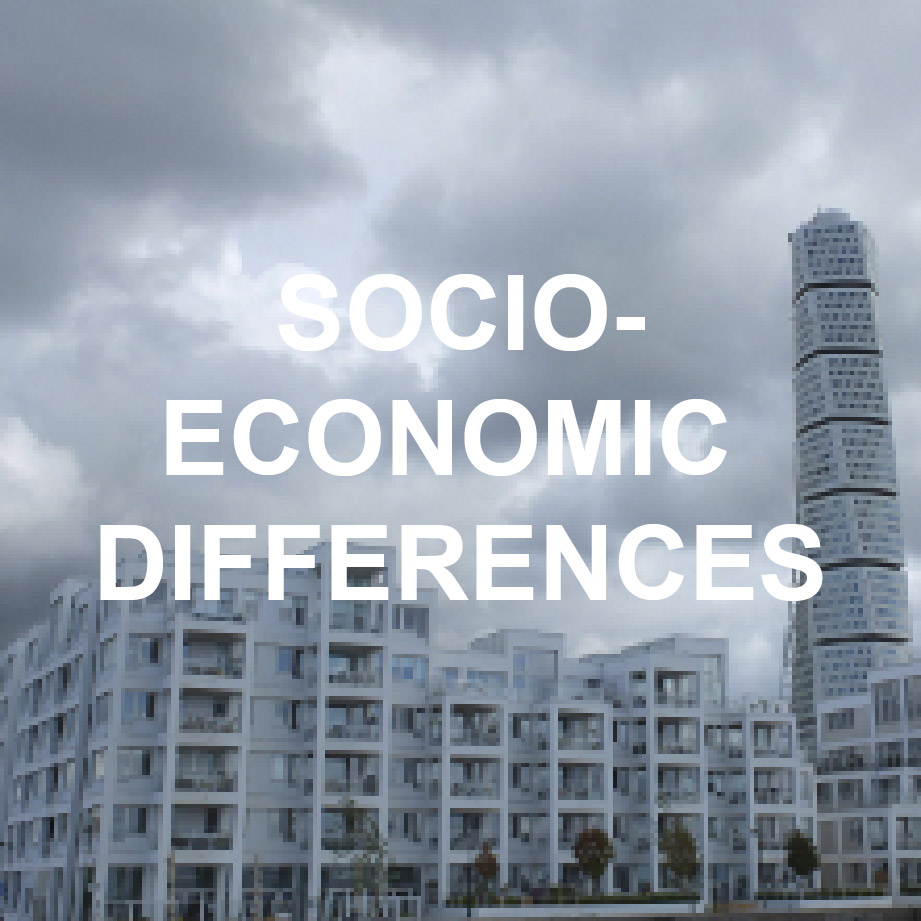



Continuous urbanization
During the last 20 years, 97% of the population growth in the Nordic region has occurred in 30 functional urban areas. Accommodating this growing population with housing, infrastructure, services and so forth, in a sustainable way, is the overarching challenge. Urbanization processes are concentrating people and capital in expanding functional urban areas . Therefore, many contemporary problems related to sustainable development, such as co-ordinating land use, transport and housing, are best approached at the city-regional scale. However, consideration of city-regions as functional urban areas challenges traditional spatial planning and policy strategies, especially within the Nordic systems, where regions have limited influence in between strong national governments and independent municipalities.
FORTSAT URBANISERING --- KAUPUNGISTUMISEN JATKUMINEN --- VIÐVARANDI ÞÉTTBÝLISMYNDUN --- FORTSATT URBANISERING --- FORTSATT URBANISERING
Densification and mixed functions
Compact city development is a paramount urban policy in the Nordic region, but implementing this in practice is challenging. For example, the best way to locate and mix different urban functions and to maintain a good quality of life in urban areas, which are becoming denser, is not immediately evident. The notion of the compact city is the paramount policy approach directed towards sustainable urban development and attractive urban areas in Nordic cities. It is an approach focused on urban form and on combating urban sprawl. It is based on the premise that a compact city structure reduces transport needs, energy consumption and public investments in infrastructure through efficient land use. However, compact city development is not a simple issue, or an undisputed idea, because it can also create land-use conflicts, increase pressure on public spaces and green areas, and contribute to increasing house prices and gentrification.
FORTÆTNING OG BLANDEDE FUNKTIONER --- KOMMUNIKATIIVISEN SUUNNITTELUN KÄYTÄNTÖJEN TOTEUTTAMINEN --- ÞÉTTING OG BLÖNDUN BYGGÐAR --- FORTETNING OG FUNKSJONSBLANDING --- FÖRTÄTNING OCH FUNKTIONSBLANDNING
Socio-economic differences
Even though Nordic cities and regions are internationally known for social cohesion and relative social equality, a fundamental challenge is the socio-economic polarization and fragmentation within urban areas. Social polarization and growing inequality are seen as among the most severe challenges for the Nordic city-regions. The capital city-regions of Norway, Sweden, Denmark and Finland all show patterns of socio-economic segregation. Spatial planners in the 21st century need to take diversified lifestyles and mobility patterns into account to help to achieve sustainable city-regions. The effect of urban structure and built environment on the social cohesion of Nordic societies is a subject of ongoing research, but we still need deeper knowledge.
Diverse everyday lives
Diversified lifestyles and mobility patterns across municipal, regional and national boundaries, in and around Nordic cities and regions, create new challenges for spatial planning in the 21st century. Quality of life is important to current Nordic spatial planning – especially since adoption of the compact city as the dominant approach to both accommodation of population growth and facilitation of economic growth in the Nordic countries. The effect of densification on social life is debated; a compact city structure will not automatically lead to more liveable cities or better everyday life for the residents. A thorough understanding of the effects of compact urban form on different groups of residents, and how this should reflect the needs of different groups in society, is crucial to effective policy application. Because people have different possibilities, needs and preferences about how to live their lives, urban form needs to support diverse lifestyles.

Main findings from the projects
The main conclusions from projects conducted by Nordregio on behalf of the NWG4 in between 2013 and 2016 follow. These projects specifically focused on how spatial planning can contribute to green growth and on issues related to urban form, social cohesion and diversity.
Weak links between spatial planning and green growth policies
Nordic cities are in many ways world-leading role models when it comes to sustainable development, especially in terms of ecology and technology (eco-tech). The green growth concept is thus, unsurprisingly, an important example of Nordic collaboration, and there have been many achievements with regard to economy, technology andecology (see, for example, the Nordic Working Group for Green Growth: Innovation and entrepreneurship). As green growth policies are currently structured in the Nordic countries, urban form is a key dimension within which green growth policies interact with spatial planning.
On behalf of the NWG4, Nordregio reviewed the relations between green growth and spatial planning in urban policy in the Nordic region. It was concluded that explicit links between green growth policies and spatial planning are quite weak because green growth policies are mainly framed at the national level and focused on regional development, while spatial planning is primarily done at the local and regional levels. Planning policies normally relate to ‘sustainable development’ rather than to ‘green growth’,but there are many implicit links to green growth policies, especially through a joint focus on urban form as a vehicle towards economic, ecological and social sustainability. The compact city is conceptualized as an attractive urban form that can contribute to green growth.The project showed that green growth polices in the Nordic countries are generally in line with the definition used by the Organisation for Economic Co-operation and Development (OECD), which is focused on economic efficiency and environmental protection, and explicitly neglects social sustainability.
However, in practice, in Iceland and Finland, for example, social aspects are to some degree integrated in green growth policies. The adoption of an everyday life perspective in regional planning is expressed in the project as a possible way forward for integrating social sustainability issues in the planning of sustainable city-regions.
City-regional planning for everyday life – lessons from the local level
In one project, the notion of everyday life as an approach in spatial planning at city-regional level was explored. The project focused on four city-regions: Aalborg in Denmark, Tampere in Finland, Stavanger in Norway, and Malmö in Sweden. In addition to interviews with planners from the different city-regions and reviews of key planning and policy documents, a workshop discussed everyday life perspectives in city-regional planning.
Although everyday life perspectives are not always a visible or literal component in plans and polices, the four city-regions expressed this philosophical inclination in varying degrees. In planning practice, a number of innovative practical approaches have been developed and used to satisfy the fundamental objectives arising from everyday life demands. Recognition of, and concern for, the inclusion of everyday life perspectives in planning makes the question of methodology central and highlights the importance of knowledge production. In the four city-regions, there are different emphases on what kind of information is considered to be important as a basis for planning.
There is a general bias, on a city-regional level, towards quantitative data with less focus on qualitative narratives about different groups of people in different spatial settings and how they choose, or would prefer, to deal with the complexities of everyday life. This approach raises questions regarding the basis for planning and the extent to which normative visions, about how people should live their everyday lives, relate to empirical knowledge about the actual lives of different groups of people.
Urban social sustainability requires holistic policies
The Nordic Council of Ministers’ Committee of Senior Officials for Regional Policy (EK-R) commissioned Nordregio to review research on residential segregation in the Nordic capitals and to provide examples of urban social sustainability policy responses.The project found three main factors explaining Nordic urban segregation: housing policy, spatial planningand discrimination. Policy responses to socio-economic polarization and fragmentation in the Nordic countries such as area-based approaches, social mix policies, expert commissions and urban development ‘think tanks’ do have an effect on urban development – and on our knowledge of social sustainability in cities – but it is important to emphasize that no approach is effective on its own since urban segregation is a complex and multidimensional problem. To succeed with planning for social sustainability in larger Nordic city-regions, a spatial justice-oriented approach is recommended. This means, based on the conclusions from the study, that planning should avoid gentrification in regeneration or development projects, respond to shortages of affordable housing, and have a holistic perspective of the city when planning new areas.
